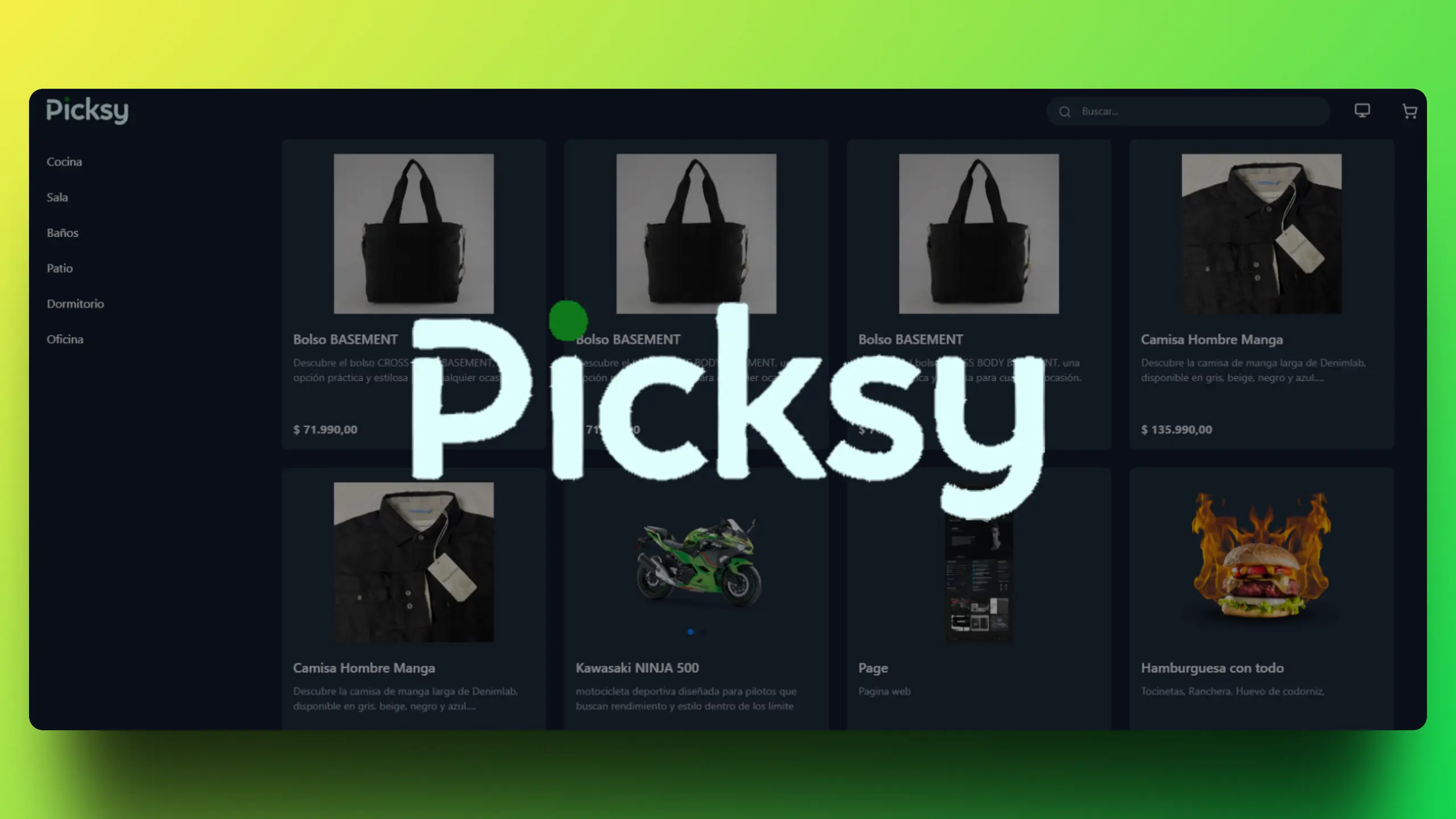Picksy E-Commerce

Multi-tenant e-commerce platform built with a modular architecture to manage independent stores. Integrates advanced customization systems, real-time analytics, and optimization tools.
- General
- Technical
Picksy is a multi-tenant e-commerce platform designed to deliver scalable and customizable solutions for complex commercial environments. Developed as a prototype for Orderly’s SAS, it emerged from the need to explore modern architectures that combine performance, flexibility, and centralized management. The project, led by lead developer Jorge Velasquez, was built through a collaborative fork, prioritizing experimentation with emerging technologies and agile development practices.
Technical Description & Features
Picksy operates under a modular architecture that clearly separates frontend from backend, enabling independent evolution of each component. Its core lies in hosting multiple stores under a single domain, where each business autonomously manages its digital presence without interfering with others.
Technological Pillars
- Hybrid Frontend: Combines Astro for static page generation (e.g., catalogs, landing pages) with Next.js for dynamic routes (shopping carts, user dashboards). This integration enables load times under 2 seconds for static content and support for complex interactivity.
- RESTful Backend: Built with Node.js and Express, offering over 30 endpoints for JWT authentication, product CRUD, order processing, and inventory synchronization. View it here.
- Relational Database: Uses PostgreSQL with schema partitioning to isolate data between stores, ensuring security and efficiency in bulk queries.
Key Features
- Secure Multi-Tenancy: Each store operates on a unique subdomain (
store.picksy.com) with role-based access policies (admin, editor, customer). - Real-Time Customization:
- WYSIWYG editors to modify themes (colors, fonts, layouts).
- Automated QR code generation linked to products, with scan metrics in dashboards.
- Promotional Engine:
- Seasonal discounts, single-use coupons, and volume-based purchase rules.
- Visible countdown timers for flash deals.
- Built-In Analytics:
- Dashboards with interactive charts showing conversions, cart abandonment, and inventory trends.
- CSV/PDF report exports for integration with external tools.
Architecture & Data Flow
| Component | Technologies | System Role |
|---|---|---|
| Rendering | Astro (SSG), Next.js (SSR/ISR) | Delivers static pages for SEO and dynamic pages for interactive user flows |
| API | Node.js, Express, Prisma ORM | Manages authentication, webhooks, and database synchronization |
| Storage | PostgreSQL, AWS S3 (for media) | Hosts structured data and media files with geo-redundancy |
| Deployment | Vercel (frontend), Render (backend) | Implements CI/CD with auto-rollback and uptime monitoring |
Technical Challenges & Roadmap
Picksy faces critical scalability challenges, many to be addressed in future iterations:
-
Performance Optimization:
- Reduce Time to First Byte (TTFB) on dynamic pages via API-level caching.
- Implement Server-Side Rendering (SSR) for product pages to improve SEO and perceived speed.
-
Smart Search System:
- Replace keyword search with an engine supporting nested filters (price, ratings, custom attributes).
- Add real-time suggestions and spell-check corrections.
-
Multi-Tenant Scalability:
- Migrate to microservices architecture to isolate failures (e.g., standalone payment service).
- Adopt GraphQL to minimize over-fetching for stores with 10,000+ product catalogs.
-
Global E-Commerce:
- Integrate local payment gateways (e.g., PSE for Colombia, Pix for Brazil).
- Auto-translate content using APIs like DeepL, with RTL (right-to-left) support.
Impact & Projection
As the foundation of Orderly’s SAS, Picksy demonstrates how a well-structured tech stack can adapt to diverse markets.
The platform not only addresses immediate e-commerce needs but also lays the groundwork for:
- IoT Integration: Use QR codes to link physical products with digital warranties.
- Subscription Models: Manage recurring memberships with prorated upgrades in real time.
- Unified Marketplace: Enable cross-store purchases in a single cart with consolidated shipping.
Its success hinges on balancing technical innovation with commercial pragmatism, offering a robust alternative to generic SaaS solutions like Shopify or WooCommerce for specialized use cases.